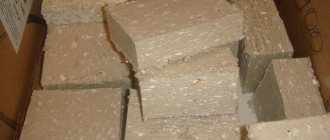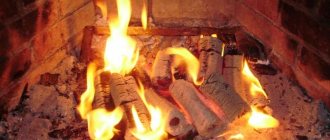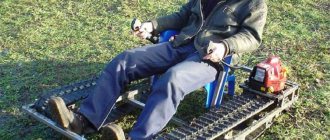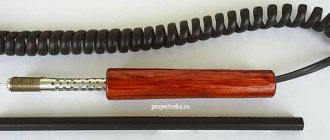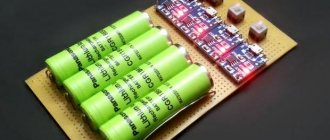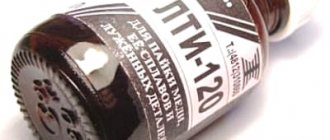It cannot be denied that sawdust briquettes are one of the most efficient types of solid fuel used for heating a home. They are high in calories (heat output is about 5 kW per 1 kg when burned), have a low ash content, and are also easy to store because they take up little space. But this fuel certainly cannot be called cheap; not everyone can afford to heat a boiler or stove with European wood throughout the entire season.
This is where many homeowners become interested - is it possible to somehow make fuel briquettes with your own hands? Especially when there are raw materials for this at a meager price. The solution to this issue is precisely the topic of this article. It will examine various technologies for producing briquettes from sawdust and other types of raw materials in production and at home. As a result, it will become clear under what circumstances it makes sense to take on this matter.
Methods for making briquettes
To get an idea of how you can make fuel briquettes with your own hands, you must first study how they are produced in a factory. The preparatory stage for any technology is the same and consists of grinding and drying the raw materials. These are, of course, sawdust and larger wood waste, which are processed to make briquettes. Then the raw material is dried in order to bring its moisture content to no more than 8-10%.
For reference. Also, various agro-industrial wastes (husks, seed husks) and even coal dust can serve as the starting material for the production of Euro-firewood.
Then the main operation begins - briquetting, in other words, sawdust pressing. Today this is done in two ways:
- Forming briquettes from sawdust on a hydraulic press.
- Production by extrusion method.
It must be said that with both technologies the result is achieved through strong compression of wood raw materials, as a result of which a natural component begins to be released from it - lignin. It serves as a binder for this crumbly mass; no other is provided. The only difference is in the compression method; in the first case, a hydraulic press for briquettes is used, developing a force of 300-600 Bar.
Due to such compression, the raw material spontaneously heats up, which only contributes to the formation of a strong rectangular “brick”. How a briquetting line with a hydraulic press functions is shown in the video:
This is how European firewood is squeezed out using a screw press
The extrusion method for producing briquettes from sawdust can be easily understood using the example of an ordinary home meat grinder or juicer. Raw materials are loaded into the receiving hopper of the unit and moved by a screw into a tapering conical working channel. There it is compressed, while the screw press for briquettes develops a monstrous force - up to 1000 Bar.
The output is firewood from sawdust in the form of a hexagon, which undergoes additional heat treatment and is cut to one size with a special knife. The sectional structure of a screw press for sawdust is shown in the drawing:
The main load falls on the auger (item 5) and the conical bushing (item 7), wear of the parts directly depends on the number of extruded briquettes
What are sawdust briquettes?
In an unprepared form, heating with sawdust is not profitable due to the low heat transfer efficiency. To increase efficiency, they are briquetted by compaction. Briquettes have a humidity level of 10 to 12% and a heat output of 4500 kcal/kg. This efficiency is 2-4 times higher than that of firewood. This is the reason for the popularity of the finished briquetted product.
The production of briquettes is popular among manufacturers due to the benefits and low cost of production. Woodworkers have the opportunity to achieve waste-free production.
Sawdust is pressed without additives. The compaction process releases lignin, a natural adhesive substance that provides high strength.
Making at home
It is clear that purchasing such powerful equipment to press briquettes at home is a fool’s errand. Even if you have the funds and free raw materials, you will be able to recoup its cost only if you press firewood from sawdust for sale. This means that it will not be possible to maintain traditional technology for lignin extraction.
Clue. Waste from winter tree pruning is perfect for briquetting if it is first crushed with a crusher. Read about the process of assembling such a branch chopper in a separate material.
Instead, home craftsmen have adapted to using different binders to form “bricks,” for example:
- wallpaper or other cheapest glue;
- clay;
- paper, corrugated cardboard.
In order not to buy expensive drying and pressing equipment, fuel briquettes are made at home as follows. Sawdust is soaked in water and thoroughly mixed with clay in a ratio of 1:10, or soaked cardboard or wallpaper glue is added. The resulting mixture for making briquettes is placed in the form of a homemade manual sawdust press and compressed by hand. Then the “brick” is removed from the mold and placed to dry naturally, outside.
For reference. Using this technology, savvy owners press briquettes from any available materials that can burn: straw, paper, cardboard, leaves, seed husks, and so on.
Production for sale
In order for the production of briquettes for sale to be profitable, it is necessary to find not only sales, but also markets.
In addition, it is advisable to purchase equipment without resorting to a loan, so at first you can take a used line.
It will cost 2-3 times cheaper than a new one.
The cost of such a used line is 1–4 million rubles, depending on performance and condition.
It includes all the necessary equipment, that is:
- press or extruder, depending on the type of briquettes;
- dryer;
- sawdust hopper;
- cyclone filter;
- Remote Control;
- conveyor.
For the production of briquettes, no special permit or license is required, however, it is necessary to obtain a sanitary and epidemiological certificate confirming the safety of transported and purchased sawdust.
This requirement was put forward by Rospotrebnadzor in order No. 776 dated November 21, 2005.
After this, you need to buy or rent a plot of land on which you will need to build all the necessary buildings. You can also find a site with ready-made buildings, which may be in good condition or require repairs.
Among other things, you will need workers, including:
- technologist;
- equipment setup specialist;
- accountant;
- driver;
- a loader with documents allowing him to operate a forklift;
- slinger;
- crane operator;
- workers.
After making fuel from sawdust, you will have to not only store it, but also immediately pack it in plastic film, which will protect the briquettes from moisture accumulation.
And given that large buyers take a batch of several tens of cubic meters, the size of the room must be appropriate.
To search for places of sale, you can use any media and conduct advertising campaigns on them.
Advertising in newspapers, radio and especially television is expensive, so for starters you can get by with advertising on such Internet platforms as:
- Avito.
- Flagma.
- Yandex Market.
- Regmarkets.
- Price pulse.
- Yula.
Another way to find a buyer for sawdust fuel is by posting advertisements on poles and notice boards.
This action will have the maximum effect in villages where there are many farmers, because the standard of living there is quite high, and gas is not always available everywhere.
Therefore, there is a high probability that someone will want to heat their house with European wood.
Equipment for the production of
The simplest press for making fuel briquettes, made by yourself, has a manual screw drive.
A molding container with perforations is filled with the mixture and placed under the bed; pressure is created by tightening the screw. The design is very simple and there is no point in talking about it in detail, just look at the drawing. Such screw machines for pressing briquettes from sawdust are not very popular due to their low productivity. It takes too much time to load the container, tighten the screw and remove the finished product. It is much faster and easier to squeeze out “bricks” using a homemade press with a long lever and a mechanism for pushing the briquettes out. To speed up the process, you can weld 2 molds to the frame instead of one.
Manual machine for 2 molds with a pipe lever
Some craftsmen can boast of more advanced mechanized equipment. Indeed, a manual machine can be improved and briquette productivity can be increased by installing a hydraulic jack instead of a manual drive. To assemble such a unit, you will have to tinker a lot, but the result will be much better.
Manual machine with hydraulic jack
Note. Even using a hydraulic jack in a homemade press, it will still not be possible to create a pressure of at least 300 bar. Therefore, it will still not be possible to reproduce the factory technology without adding water and binders.
Despite great difficulties in manufacturing the parts, some of the craftsmen managed to assemble a screw press and obtain briquettes of fairly decent quality. This is evidenced by the reviews of such people on the forums. But they all note the high costs of producing screw parts and housings from high quality steel. Again, you can’t do without an electric drive; at the most conservative estimate, a motor with a power of at least 7 kW is required.
Briquetting Line Suppliers
| № | Name | Cost, pcs. | Provider |
| 1 | Imported new line-plant for the production of pellets from 1500 kg/hour | From 9 million rubles. | LLC RosIndKo (St. Petersburg) |
| 2 | Press Ruf for the production of fuel briquettes (volume not specified) | 180 thousand rubles. | LLC "Chernomorsky Trading House" (Krasnodar region) |
| 3 | Hydraulic press for the production of fuel briquettes Nestro, new | 600 thousand rubles. | Private person |
| Hydraulic press for the production of fuel briquettes Nestro, used | From 90 thousand rubles. | Private person | |
| 4 | Used briquetting press PB 400 kg/h | 390 thousand rubles. | LLC NGSBP (Krasnodar region) |
| 5 | Press for fuel briquettes from vegetable raw materials, 35-180 kg/h, made in Germany | 850 thousand rubles. | Agro-industrial technologies (Yurga, Kemerovo region, Russia +7) |
| 6 | Impact press for sawdust briquetting GC-1000 at 0.8…1 t/h | 3.25 million rubles. | LLC Eurasia-Vostok (Blagoveshchensk) |
| 7 | Dryer type AVM-650, new. | 150 thousand rubles. | Private person |
| 8 | Drying type AVM-650, used. | 90 thousand rubles. | Private person |
| 9 | Aerodynamic dryer SAD-0.6-1.2 with a capacity of 600 kg/hour | 1.3 million rubles. | LLC Stankostroitelny (Voronezh) |
| 10 | Chinese low power lines up to 250 kg/hour | 200 thousand rubles. (per unit of equipment in the line) | Private person |
| 11 | Chinese medium power lines from 500 kg/hour | 2.5 million rubles | Private person |
Homemade briquettes - pros and cons
The reasons why this type of fuel is very attractive are clear. When a person has his own wood production or the opportunity to cheaply buy sawdust for briquettes, then thoughts about making them at home are quite natural. The fact is that not every heating equipment is suitable for burning sawdust. As a rule, fine wood in a conventional stove or boiler burns quickly and gives off little heat, and even half will spill into the ash pan.
To successfully burn wood waste, you need a special shaft-type or top-burning boiler. It’s quite difficult to make this; the prospect of pressing sawdust into fuel briquettes seems much brighter.
It turns out that not everything is so simple here either, and here’s why:
- Buying factory drying and pressing equipment is an unreasonably expensive undertaking. It is cheaper to purchase ready-made European firewood.
- You can make a briquette press yourself and make them in an artisanal way. But the products will be of low quality and will provide little heat, and will take a lot of time.
After squeezing out the water and subsequent drying, the briquette becomes quite light.
Point two requires clarification. Due to the impossibility of following the technology, the “bricks” after drying are light due to their low density. Their specific heat of combustion is three times lower than that of wood, which means that for heating they will need three times as much. The whole process will take a lot of time and consume a lot of energy. And it is very difficult to store such a volume of fuel so that it does not accumulate moisture.
Educational video for enthusiasts who want to start manual briquetting of various household waste:
Why are briquettes good?
Fuel briquettes are crushed wood and wood waste, compressed into a form convenient for transportation and storage.
As a result of processing on machines by pressing under high pressure, the finished briquettes acquire new qualities. Their use instead of conventional firewood in stoves, fireplaces and wood-burning boilers provides the following advantages:
- increased combustion temperature and, accordingly, better heat transfer;
- a higher density of briquettes leads to longer burning of the same volume;
- reduced formation of soot and ash residues;
- Briquettes are produced in various shapes - short cylinders, rectangular bricks. But in any case, they are convenient for storage and carrying.
When compared with conventional firewood, Euro-firewood will not be worse in any respect. The disadvantages include the fact that by the appearance of the briquette it is not always possible to determine the specific wood from which it is made. And if, for example, birch briquettes are required, then you have to rely on the integrity of the manufacturer.
Wood processing line
An environmentally friendly approach to consumed natural resources includes the possibility of their recycling. A significant part of the recycling segment is occupied by wood processing. This process can be carried out in several ways: chemical, mechanical, mechanical-chemical. The choice of technological method will depend on the planned final product of such processing.
- A mechanical change in the original type of wood occurs by chopping, sawing, milling, turning, splitting, peeling, drilling or planing. The result of processing is lumber or fibrous semi-finished products. If wood fibers are pressed under high pressure, the result will be the production of pellets - fuel granules with extreme energy concentration.
- The combination of mechanical change and chemical change produces a homogeneous wood product - shavings, chips and veneer, from which modified wood is subsequently made. The intermediate wood product (obtained mechanically) undergoes polymerization through a synthetic binder under pressure and a certain temperature. This is how plywood, chipboard, fiberboard, and OSB are produced.
- A purely chemical method of processing with alkali or acid is used to obtain gum, solvents, tanning agents, rosin, filler components for varnishes, bitumen from wood, and also as a raw material in paper production.
The choice of specialized equipment involved in multi-variant wood processing lines is huge. Therefore, the configuration of capacities should be carried out in accordance with the planned end result.
I would especially like to draw attention to the production of wood chips, or the “building stone” of the future (as it is otherwise called). Being the basis for the integrated waste-free use of forest resources, it opens up new opportunities in the recycling and disposal of any type of wood. The line for processing wood into chips is the most in demand in this production segment.
The line for processing wood into chips is the most popular in this production segment.
Due to its mobility and compactness, such a plant can be used at all stages of wood harvesting and processing (from grinding directly in forest clearings to processing waste from large wood processing complexes). Some physical and mechanical properties of sawdust
| Wood sawdust | Bulk density, kg/m³ | Humidity,% | Characteristic dimensions, mm | Windage factor |
| dry | 220-420 | 8-15 | up to 50 | 0,13-0,8 |
| wet | 320-580 | more than 15 | >> | no data |
Based on sawdust, a material such as paykerite was created - a frozen mixture of sawdust and water, which is 4 times stronger than ice and melts much slower.
Sawdust is most often burned in sawmills.
Classification of briquetted products
In accordance with the listed technologies and equipment used for production, three types of briquettes are distinguished:
- In the form of a brick, obtained by hydropressing under pressure up to 400 bar (about 4 kgf/cm2).
- Cylindrical - about 50 cm long, 10 cm in diameter, using hydro- or mechanical pressing methods with pressure from 400 to 600 bar (4-6 kgf/cm 2 ).
- Piney-key - with radial holes, obtained by processing on screw (extruder) presses, while simultaneously exposed to high pressure (up to 110 bar) and high temperature (250-350 o C). They differ in combustion duration, increased heat transfer, density and resistance to impact.
The density of briquettes is a fundamental value that directly affects calorie content, mechanical resistance, and resistance to moisture.
Briquetted products warehouse
The higher the density, the higher the listed indicators accompanying it. Which fuel briquettes are better is up to consumers to decide, in accordance with their own needs and preferences.
Fuel briquettes RUF
This fuel resembles white or wood-colored bricks in appearance (the shade varies widely). RUF briquettes are made from dry sawdust by pressing under high pressure. As a result, Euro-firewood is born, which can be used in any type of stove. Their distinctive feature is the inscription RUF, embossed on both sides.
Eurobriquettes PINI KAY
An interesting feature of these Eurobriquettes is their unusual shape - they resemble square pencils from which someone has taken the lead. That's why they are called "pencils". In order for it to burn with the release of a large amount of heat, a hole is made in it, increasing the draft. The “pencils” themselves look dark, as they were fired. This procedure makes them more durable and removes excess moisture.
The disadvantage of PINI KAY fuel briquettes for heating stoves is that they are more expensive than firewood and even more expensive than any other types of fuel. But they burn well, releasing a large amount of heat. They are also convenient to transport and store. Thanks to their shape, they are ideal for lighting fireplaces. Some people take them with them into the wild to use PINI KAY bars instead of wood for a fire.
Fuel briquettes from coal and peat
Peat and coal fuel briquettes for heating stoves are made from peat and coal, respectively. The starting materials are formed into small cylinders. The fuel can be used to light stoves and solid fuel boilers. Coal products give a high combustion temperature, but are characterized by high ash content. As for peat fuel, it is ideally suited for long-burning stoves, but it also produces a lot of ash.
Simple cylindrical briquettes
The simplest fuel briquettes for heating stoves are also on sale - in the form of cylinders. They are made from pressed sawdust and small wood waste. All this is pressed under slight pressure using a non-toxic adhesive base, after which the finished bars are sent to consumers. This fuel is cheap, but has one distinct drawback - low strength. It easily disintegrates and crumbles and does not withstand exposure to moisture.
Advantages of Eurowood
Briquettes for combustion are a natural product without additives or binders, with a moisture content of no more than 10% by weight. The product is suitable for use in boilers and furnaces of all types.
In comparison with other classic types of solid fuel (wood, coal), Eurofirewood has the following advantages:
- The burning time is 3.5-4 times longer than firewood. A sawdust briquette burns with an even flame without the formation of sparks, with a small amount of smoke, with minimal smoke formation, and does not “shoot.”
- 1 ton of compressed fuel emits as much heat as a full dump truck of firewood – 7 m3.
- The high calorific value of fuel briquettes, even with low draft, is comparable to that of coal and is 2 times higher than this value for firewood.
- After their combustion, up to 1% pure ash remains. For comparison: burning wood leaves 15-20%, coal – up to 40%.
- The environmental friendliness of Euro firewood is evidenced by the absence of hazardous volatile substances and soot in combustion products. In this case, carbon dioxide is released 15 times less than when burning natural gas and 50 times less than from anthracite.
- When servicing boiler equipment, material and time costs are reduced, and the operating life of heating systems is increased.
- The cost of heating a building with compressed sawdust is significantly reduced.
- Briquettes are stored compactly, do not take up extra space, and are convenient for transportation.
